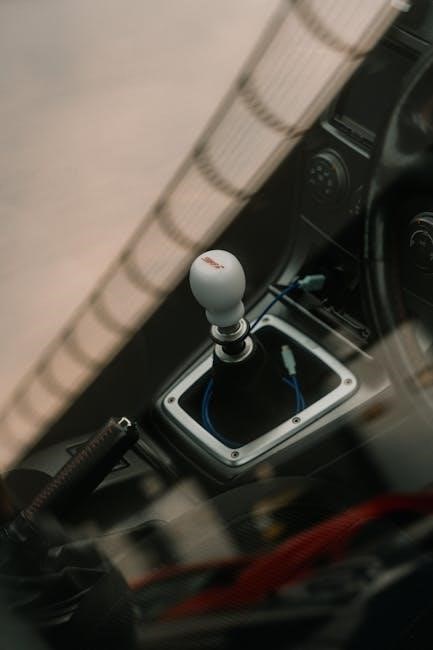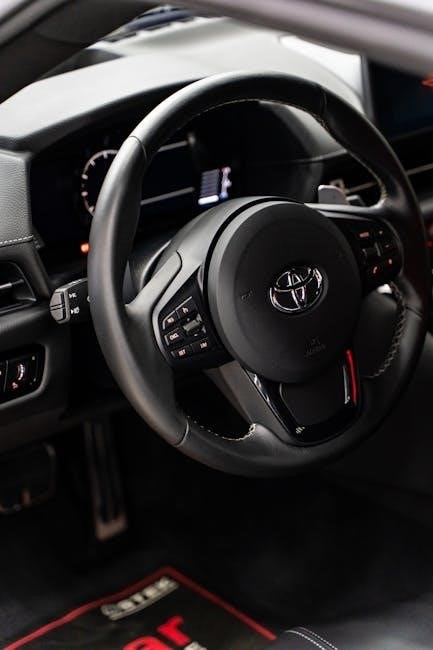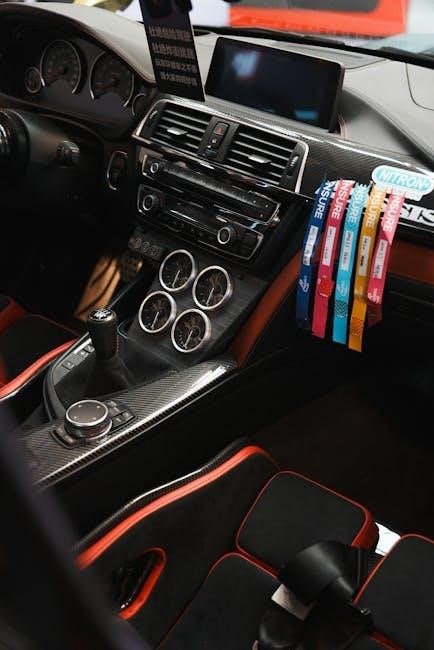Manual Shifter for Automatic Transmission: A Comprehensive Guide
This guide provides a comprehensive overview of manual shifters used with automatic transmissions․ It explores their benefits, components, and installation․
Manual shifters with automatic transmissions offer a unique blend of control and convenience․ Unlike converting an automatic to a full manual transmission, which is a huge job, these shifters allow drivers to manually select gears within the automatic system․ While a “click and go kit” for fully converting an automatic transmission to manual isn’t feasible, these shifters provide a degree of manual control․ This setup differs significantly from simply swapping a manual transmission for an automatic one, focusing instead on enhancing the automatic driving experience․ Explore how these systems bridge the gap between fully automatic and manual control, adding a sporty feel․
Benefits of Using a Manual Shifter with an Automatic Transmission
Using a manual shifter with an automatic transmission enhances driving by offering more control․ It can also potentially improve fuel efficiency compared to standard automatic mode․
Improved Fuel Efficiency
Employing a manual shifter with an automatic transmission can yield improved fuel efficiency in certain scenarios․ Studies suggest that manual transmissions can enhance gas mileage by 2 to 5 mpg compared to automatics․ This improvement stems from the driver’s ability to select optimal gears for different driving conditions․ Unlike automatics, manual control allows for preventing unnecessary downshifts or high-RPM driving, leading to fuel savings․ However, fuel efficiency heavily relies on the driver’s skill and driving style, as inefficient gear selection can negate potential gains․
Enhanced Driving Experience and Control
Using a manual shifter with an automatic transmission offers an enhanced driving experience by granting the driver greater control over gear selection․ This setup combines the convenience of an automatic with the engagement of a manual, allowing for quick downshifts for overtaking or maintaining optimal engine speed on hills․ Drivers can tailor the transmission behavior to their preferences and road conditions, providing a more responsive and involved experience․ This added control can also improve handling and stability, particularly in challenging driving situations, offering a more connected feel to the vehicle․

Components of a Manual Shifter Conversion Kit
A manual shifter conversion kit typically includes essential components like the clutch pedal assembly, master and slave cylinders, and the clutch actuating rod, ensuring a comprehensive setup․
Clutch Pedal Assembly
The clutch pedal assembly is a fundamental component in a manual transmission conversion․ This assembly allows the driver to manually disengage the engine from the transmission, facilitating gear changes․ It typically includes the pedal itself, along with the necessary linkages and mounting hardware to connect it to the master cylinder․ Proper installation and adjustment of the clutch pedal assembly are crucial for smooth and reliable clutch operation․ The assembly also has to be correctly sized and matched to the vehicle’s specifications, ensuring compatibility and optimal performance․
Master and Slave Cylinders
The master and slave cylinders are essential hydraulic components of a manual transmission conversion․ The master cylinder, connected to the clutch pedal, converts mechanical force into hydraulic pressure․ This pressure is then transmitted through a hydraulic line to the slave cylinder․ The slave cylinder, located near the transmission, converts the hydraulic pressure back into mechanical force, which actuates the clutch release mechanism․ Proper sizing and compatibility of these cylinders are vital for optimal clutch engagement and disengagement․ Any leaks or malfunctions in these components can compromise clutch performance․
Clutch Actuating Rod
The clutch actuating rod, also known as a pushrod, plays a critical role in transmitting force from the clutch pedal to the master cylinder․ It directly connects the pedal to the master cylinder piston․ When the clutch pedal is depressed, the rod pushes the piston, generating hydraulic pressure within the master cylinder․ The length and adjustability of the actuating rod are crucial for proper clutch pedal feel and engagement․ Incorrect adjustment can lead to issues such as incomplete clutch disengagement or excessive pedal travel, impacting shifting performance․

Installation Process: Converting to a Manual Shifter
Converting to a manual shifter involves a detailed process․ This requires careful planning․ It also requires precise execution to ensure proper functionality․
Step-by-Step Guide
The first step involves gathering the necessary components, including the clutch pedal assembly, master cylinder, slave cylinder, and clutch actuating rod․ Ensure compatibility with your vehicle model․ Begin by disconnecting the battery and removing the automatic shifter components․ Next, install the clutch pedal assembly and mount the master cylinder․ Connect the master cylinder to the slave cylinder using hydraulic lines․ Install the slave cylinder on the transmission․ Attach the clutch actuating rod to the clutch fork․ Bleed the hydraulic system to remove air․ Finally, test the system․

Cost Considerations for Manual Shifter Conversion
Converting to a manual shifter involves assessing both parts and labor expenses․ These costs can vary significantly based on the vehicle model and the complexity of the installation process․
Parts and Labor Costs
The expense of converting an automatic transmission to a manual one includes several components․ The clutch kit, with parts like the clutch pedal assembly, master cylinder, and slave cylinder, contributes significantly․ Flywheel costs also vary based on size․ Furthermore, professional installation by restoration specialists will affect the overall cost․ Given the complexity, labor costs can be substantial, making it vital to get an estimate․ Considering options like complete clutch linkage kits and the possibility of additional charges will provide the most accurate total expense․
Potential Drawbacks of Manual Shifter Conversion
Converting to a manual shifter can present challenges․ The installation’s complexity requires expertise․ Compatibility issues can arise․ Thorough research ensures a successful, informed decision regarding manual shifter conversion․
Complexity of Installation
Converting an automatic transmission to a manual shifter is not a simple task․ It requires significant mechanical knowledge and precision․ Unlike click-and-go kits, this conversion often involves intricate modifications to the vehicle’s drivetrain and chassis․ This complexity can be a major drawback for those without extensive automotive experience․ Proper installation ensures the system works correctly and avoids potential damage․ Seeking professional assistance from specialized shops or experienced mechanics is highly recommended to navigate these challenges and ensure a safe and reliable conversion․ Failing to do so may result in costly repairs․
Available Kits and Manufacturers
Several manufacturers offer conversion kits, including Speedway Motors and American Powertrain; These kits vary in completeness and vehicle compatibility, so careful research is essential before purchasing․
Speedway Motors Conversion Kits
Speedway Motors offers manual transmission conversion kits for various vehicles, including the 1968-72 Chevelle․ These kits provide components needed to convert from automatic to manual․ When considering a Speedway Motors kit, verify that it is compatible with your specific vehicle make, model, and year․ Research the kit’s contents and ensure it includes all necessary parts such as the clutch pedal assembly and related hardware․ Always review customer feedback and professional reviews before making a purchase․
American Powertrain Profit Installation Systems
American Powertrain offers “Profit Installation Systems” featuring overdrive manual transmissions․ These systems are designed to provide a professional fit for your car․ They focus on ensuring the transmission integrates seamlessly into the vehicle․ These systems are prepped to fit a specific car model․ Consider American Powertrain if you need a complete solution that prioritizes compatibility and ease of installation․ Look for testimonials or case studies that demonstrate the successful use of their systems in similar vehicles․
Alternatives to Full Manual Conversion
Consider gear vendor overdrive units as an alternative․ These units offer some benefits of a manual․ This provides greater control without a complete transmission swap․
Gear Vendors Overdrive Unit
A Gear Vendors overdrive unit presents a compelling alternative to a full manual transmission conversion․ It offers enhanced control and improved fuel efficiency․ Unlike a complete swap, these units integrate with existing automatic transmissions, providing an additional gear for optimized performance․ This can lead to better gas mileage on the highway․ It also offers more control over the vehicle’s power band․
The installation is less complex․ This makes it a more accessible option for some enthusiasts․ These overdrive units provide a balance between convenience and performance․ This makes them a practical choice for drivers seeking enhanced driving dynamics․
Vehicle Compatibility: Ensuring a Proper Fit
Before starting a manual shifter conversion, verify kit availability for your specific vehicle․ Compatibility ensures proper fitment and functionality․ Confirming compatibility prevents installation issues․
Checking for Kit Availability for Specific Models
Ensuring a proper fit is paramount when considering a manual shifter conversion for an automatic transmission․ Begin by meticulously researching available conversion kits tailored to your vehicle’s make, model, and year․ Consult with restoration specialists or aftermarket parts providers, who often maintain comprehensive databases of compatible kits․ Verify the kit includes all necessary components for a seamless installation, such as clutch linkage, pedal assemblies, and any model-specific adaptations․ Confirming compatibility early on prevents costly complications and ensures optimal performance of the converted system, ultimately enhancing your driving experience․

Maintenance and Care of Manual Shifter Systems
Proper maintenance ensures longevity․ Regular inspections and adjustments are crucial․ Check clutch linkage and fluid levels․ Address issues promptly to prevent extensive damage and maintain optimal performance․
Regular Inspections and Adjustments
Maintaining your manual shifter system involves consistent attention to detail․ Begin with visual inspections of the clutch linkage, searching for wear or damage․ Ensure all connections are secure and properly lubricated․ Regularly check the master and slave cylinders for leaks, which can compromise hydraulic pressure․ Clutch pedal feel is a key indicator; any sponginess suggests air in the system or a failing cylinder․ Adjust the clutch cable or rod as needed to maintain proper engagement and prevent slippage․ Consistent maintenance prolongs the lifespan of components․
